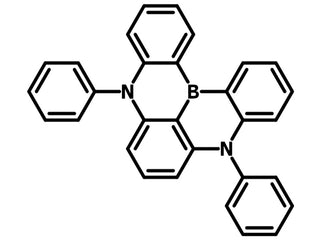DABNA-1
CAS Number 1689552-89-3
Blue Dopant Materials, Dopant Materials, High Purity Sublimed Materials, Materials, MR-TADF Materials, OLED Materials,Blue Dopant Material with Boron-based triarylamines
High purity sublimed narrowband multi-resonance thermally activated delayed fluorescent (MR-TADF) emitter for highly efficient OLEDs, 5,9-Diphenyl-5,9-diaza-13b-boranaphtho[3,2,1-de]anthracene, CAS No. 1689552-89-3, Sublimed ≥99.0%
DABNA-1 has a rigid polycyclic aromatic framework containing a triphenyl boron core and two nitrogen atoms that are connecting all five phenyl rings. Structurally, DABNA-1 also can be considered as two triphenyl amines that has one common phenyl ring which is joined by two other neighbouring phenyl rings with a boron to form a triphenyl boron central core. DABNA-1 was one of the first developed multi-resonance thermally activated delayed fluorescence (MR-TADF) materials containing one boron atom and two nitrogen atom with boron and nitrogen exhibiting the opposite resonance effect.
DABNA-1 exhibited deep blue emission with photoluminescence quantum efficiency (PLQY) and singlet–triplet energy splitting (ΔEST) of 0.88 and 0.18 eV in 1 wt.% doped mCBP film. Deep blue OLED devices based on DABNA-1 showed high efficiency with an EQE value of 13.5% and a color coordinate of (0.13, 0.09), along with high color purity of very narrow EL spectra full width at half maximum (FWHM) of 28 nm at 459 nm. Though showing high efficiency roll-off, DABNA-1 and its derivatives are promising candidates for developing high color purity, high efficiency deep blue TADF-OLEDs.
Other MR-TADF materials containing DABNA-1 core such as t-DABNA, v-DABNA and 3tPAB are also available.
General Information
| CAS number | 1689552-89-3 |
|---|---|
| Chemical formula | C30H21BN2 |
| Molecular weight | 420.31 g/mol |
| Absorption* | λmax 437 nm (in DCM) |
| Fluorescence | λem 462 nm (film) |
| HOMO/LUMO | HOMO = 5.58 eV, LUMO = 2.91 eV (ΔEST = 0.18 eV) |
| Synonyms | 5,9-Diphenyl-5,9-diaza-13b-boranaphtho[3,2,1-de]anthracene |
| Classification / Family | Triarylamine derivatives, Blue dopant, Multiresonance thermally activated delayed fluorescent (MR-TADF), Sublimed materials. |
Product Details
| Purity | Sublimed* >99% (HPLC) |
|---|---|
| Melting point | n.a. |
| Appearance | Bright yellow powder |
* Sublimation is a technique used to obtain ultra pure-grade chemicals, see sublimed materials for OLED devices.
Chemical Structure

Device Structure(s)
| Device structure | ITO (50 nm)/NPD (40 nm)/TCTA (15 nm)/mCP (15 nm): 1 wt% DABNA-1/mCBP (20 nm)/TSPO1* (40 nm)/LiF (1 nm)/Al (100 nm) [1] |
|---|---|
| Color | |
| Max Current Efficiency | 10.6 cd/A |
| Max EQE | 13.15% |
*For chemical structure information, please refer to the cited references.
MSDS Documentation
Literature and Reviews
-
Ultrapure Blue Thermally Activated Delayed Fluorescence Molecules: Efficient HOMO–LUMO Separation by the Multiple Resonance Effect, T. Hatakeyama et al., Adv. Mater., 28 (14); 2777-2781 (2016); DOI: 10.1002/adma.201505491.
-
Ternary Exciplexes for High Efficiency Organic Light-Emitting Diodes by Self-Energy Transfer, S. Jeon et al., Adv. Opt. Mater., 7 (5), 1801462 (2019); DOI: 10.1002/adom.201801462.
-
Triptycene-Fused Sterically Shielded Multi-Resonance TADF Emitter Enables High-Efficiency Deep Blue OLEDs with Reduced Dexter Energy Transfer, H. Mubarok et al., 135 (32), e202306879 (2023); DOI: 10.1002/ange.202306879.
